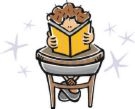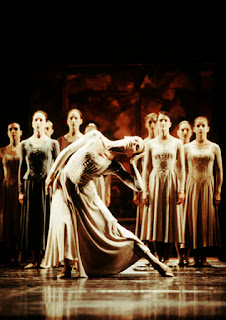As I continue reading a story a day in 2015, I sometimes find it more difficult to articulate exactly what I like about my favorite stories than to enumerate what I don't like about other stories, but my purpose here is praise rather than criticism. So I really have to work at finding the right words.
Lately I've been finding myself thinking "this is one of my favorite stories this month because . . ." and the best I can come up with is that there's nothing about the story that I would want to change. It may not be the kind of story I would normally read, or there may be something in the story that initially niggles at me, but upon reflection I realize that no, I wouldn't want to change even that one little thing. And this gives me the irrational but pleasant feeling that the author wrote the story specifically for me.
That said, I do recognize some trends in what I like. Although I certainly enjoy stories that are simply entertaining, I really get hooked by SF that packs an emotional punch. It doesn't have to be a message story; it just has to make me really care about the characters, or empathize strongly with the circumstances in which they find themselves.
Since we're halfway through the year, here's a "by the numbers" breakdown: I've read 239 stories so far this year, at least 62 of which were published in 2015. (That number is probably much larger; I have to cross-check my lists, because I forgot to enter the publication year for several of the stories.) I'd like to get to at least 500 stories this year, and up the percentage of current year publications so that I have lots of material to consider when next year's award nominations roll around.
I also looked at the ratings I've given to each story. So far I've rated 36 stories as essentially "below average," 82 as "above average" (with about 30 of those high enough to be considered favorites), and 121 as "average." I don't have any profound insights, but I'm glad to see data indicating that I like what I read more often than not, although I suspect I'm still kind of hard to please. But it's all subjective -- often times when I dislike something in a story, I know very well it's because of some personal "button" of mine that has little to do with the writing itself.
And because I like keeping track of things, I'll go on a tangent here and also mention that writing-wise, I've made 77 submissions this year, with 29 subs currently floating around out there. It's not as impressive as I'd like, because some of those are sim-sub friendly markets and others are reprint subs. But a fair few of them are new stories, and these numbers are far higher than I've ever achieved before, so I'm pretty happy. I'd like to get the subs to 175 for the year if I can. I've had one story published this year, and have four stories that have sold but have not yet appeared.
One more observation before I get to the actual stories. Even if I do hit 500 stories read for the year, it will barely be a drop in the bucket of what's available out there. There is so much good fiction to be discovered.
(alphabetical by author)
"Hellhound, Free to Good Home" by Gerri Leen
This flash fiction story is told from the point of view of a Hellhound, who is perplexed when he happens upon a woman who not only doesn't fear him, but also seems intent on rescuing him. I happen to know the author is an animal lover -- she's editing an anthology of spec fic animal stories to benefit a rescue shelter, in which one of my stories will appear -- and it shows in this piece. It's less than 750 words long. Isn't it amazing what writers can do in so few words? Read here.
As an aside, I highly recommend subscribing to Daily Science Fiction and Every Day Fiction, both of which are free. DSF publishes a new story every weekday, and Every Day Fiction posts one every single day of the year. Trust me, you'll find some gems this way.
"We Fly" by K.B. Rylander
This story won first place in the Jim Baen Memorial Short Story Award contest this year, which seeks stories "of no more than 8,000 words, that [show] the near future (no more than about 50-60 years out) of manned space exploration."
Remember what I said about liking stories that pack an emotional punch? This one nails it. It's about a spacecraft probe operated by the uploaded consciousness of a woman named Natasha; for some reason the probe is malfunctioning and this incarnation of Natasha doesn't know why. I don't want to risk ruining the story for anyone so I won't say more. But again with the patterns: this is at least the second story this year about artificial or uploaded intelligence that I've loved (the first was David D. Levine's "Damage" from Tor.com). "We Fly" can be found here.
"Amaryllis" by Carrie Vaughn
Here's another story that pushed all the right buttons for me. It's science fiction, with world-building that I love, yet it's more about standing up for oneself, children paying for the sins of the parents, and trust. The basic premise is that the captain of a fishing boat in a post-environmental-collapse community is being treated unfairly because she herself was born in violation of population controls. I can't remember where I read this remark, but someone somewhere said that they liked this story in part because it shows a positive post-disaster world, where people have learned from history and are very careful about living in a sustainable manner. As someone who composts, pays extra for wind/solar power, and drives a Prius, yes, this!
As dorky as this sounds, I felt like I could practically smell the salt air while reading "Amaryllis". If I ever achieve this kind of subtle world-building as a writer, I'll be very happy indeed. I also loved the character relationships, and the nontraditional and very positive family structure that was portrayed. Read in the June 2010 issue of Lightspeed here.
Other stories read in June 2015:
(alphabetical by author)
- "An Update on the Problem of Maria" by Matthew Belinkie (2007)
- "The Adjunct" by Patricia S. Bowne (2015)
- "Bursk's Cutting Board" by Scott Cheshire (2015)
- "Superiority" by Arthur C. Clarke (1951; reprint 1987)
- "Seated Woman with Child" by Rosemary Clement-Moore (2015)
- "Breaking the 3 Laws" by Trevor Doyle (2015)
- "Crown of May" by Jaine Fenn (year unknown)
- "First Reports on Tardive Dyskinesia Patients in Time Displacement" by Fabio Fernandes (year unknown)
- "Muzak for Prozac" by Jack Gantos (2001)
- "Cool" by Becky Hagenston (2015)
- "Anniversary Project" by Joe Haldeman, (1975; reprint 2000)
- "Athena's Children" by Travis Heermann (2015)
- "Saving Time" by John Hegenberger (2015)
- "An Undercover Haunting" by Kristi Hutson (2015)
- "Ten Wretched Things About Influenza Siderius" by Rachael K. Jones (2014)
- "Voidrunner" by Rachael K. Jones (2015)
- "I’m Alive, I Love You, I’ll See You in Reno" by Vylar Kaftan (2010)
- "An Apocalypse of Her Own, One Day" by Alex Kane (year unknown)
- "The Tear Collector" by Justin C. Key (2015)
- "End Game" by Nancy Kress (2007; reprint 2012)
- "Dreams to Dust" by Jamie Lackey (2015)
- "All the Animals and Me" by Dan Malakin (2015)
- "Carry On" by Amy Morris-Jones (2015)
- "The Dollmaker's Rage" by Mari Ness (2015)
- "Who Else Would Make a World Like This" by Stephen S. Power (2015)
- "The Reflection in Her Eye" by Shawn Scarber (2015)
- "Touring Test" by Holly Schofield (2013)
- "RedChip BlueChip" by Effie Seiberg (2015)
- "I Regret to Inform You That My Wedding to Captain von Trapp has been Canceled" by Melinda Taub (2011)
- "Flash" by Lavie Tidhar (2015)
- "Parable Lost" by Jo Walton (2009)
- "Dinosaurs" by Walter Jon Williams (1987; reprint 2000)
List of the sources from which these stories came:
(alphabetical by anthology title, magazine title, website name, etc.)
- Baen.com
- Battlefields Beyond Tomorrow: Science Fiction War Stories (anthology), edited by Charles G. Waugh and Martin H. Greenberg, 1987
- Black Denim Lit, May 2015
- Crossed Genres, June 2015
- Daily Science Fiction, various dates
- Every Day Fiction, various dates
- Fantasy Scroll Mag, June 2015
- Flapperhouse, May 2015
- Fountain of Age: Stories (collection) by Nancy Kress, 2012
- The Furthest Horizon (anthology), edited by Gardner Dozois, 2000
- Lightspeed, June 2010
- Lone Star Stories, June 2009
- McSweeney's, April 2007; May 2011
- On the Fringe (anthology), edited by Donald R. Gallo, 2001
- One Story, May 2015
- One Teen Story, June 2015
- Perihelion, March 2015; June 2015
- QuarterReads
- Strange Afterlives (anthology), edited by A. Lee Martinez, 2015
Read more!















